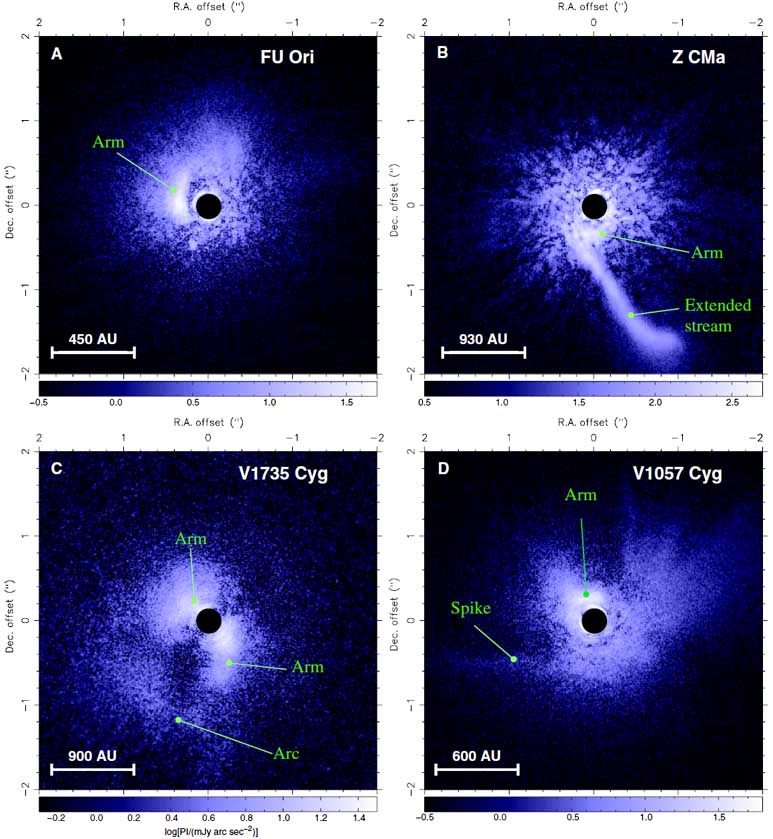New images of four disks around forming stars known as protostars suggest that the star formation process is much more violent than previously thought.

Hauyu Baobab Liu et al.
A star’s birth is somewhat of a mystery. Because they form behind an enormous veil of dusty — and often beautiful — molecular clouds, nature blocks the details from view. But astronomers think that within these clouds, small pockets of gas begin to collapse under their own gravity into protostars, fed steadily by spinning gaseous disks.
A new study, however, published February 5th in Science Advances, suggests that this slow and steady accretion might not win the race after all. It’s more likely that matter in the circumstellar disk piles up and then dumps onto the protostar in episodic bursts.
See, there’s always been a problem with the previous theory: when astronomers actually observe these protostars in action, they appear far too faint. In other words, far too little matter is accreting onto these protostars at any given time — there’s simply no way a protostar could become a full-fledged star in just a few million years at such low luminosities. At least not if the process is slow and steady.
At the same time, a handful of protostars are known to brighten by a factor of more than 100 in just a matter of decades before they settle back down. Looking at these clues side by side, astronomers drew the obvious conclusion: the protostars are growing in violent fits and bursts. Because these episodes of intense accretion don’t happen often, astronomers are less likely to see the stars-to-be in the bright phase.
“It’s like stars form when you’re not looking,” says Michael Dunham (Harvard-Smithsonian Center for Astrophysics).
But observers have been unable to provide direct evidence of episodic accretion, and theorists don’t like the extra mess it adds to their models. So Hauyu Baobab Liu (Academia Sinica Institute of Astronomy and Astrophysics, Taiwan), Dunham, and their colleagues decided to take a closer look at the circling disks around four extremely bright protostars. They were looking for the smoking gun of episodic accretion: gravitational instabilities in the disk should lead to visible pile-ups such as clumps and streamers.
Seeing circumstellar disks in such detail is no easy task. First the team had to use adaptive optics to overcome the Earth’s atmosphere, which blurs details. Then the team had to block out the protostar’s light with a coronagraph in order to see the faint disk. Finally, the team used a technique called polarization differential imaging, which compares two images of the light scattered from different directions to better see surface features. Dunham says this technique can be used to take a picture of a mountain range through a thick fog.

Hauyu Baobab Liu et al.
Oh, and they observed these disks on the Subaru telescope on Mauna Kea, one of the largest telescopes in the world. At the end of the day, their diligence was worth it. “I’ve never seen anything like this in terms of the observations,” says Chadwick Young (Nicholls State University), who was not involved in the study.
All four images show arms, arcs, or streams. Although it’s what the team had hoped for, Dunham was surprised that the images were so spectacular. “There are these arc-like features. There’s even one case where there's the streamer coming out of the disk . . . and that's exactly what the models and the computer simulations of this process predicted.”
Another expert is still holding out for more: “It's one more important bit of evidence that the picture holds together,” says Neal Evans (University of Texas), who was not involved in the study. Next, he’d like to see the team observe at another wavelength. The scattered near-infrared light the astronomers imaged only probes the disk’s surface. But at a different wavelength, say, radio waves, the team could actually peer inside these dusty features and verify that they persist throughout the disk.
Lucky for Evans, the team plans to do just that. In addition, Dunham says the team would like to observe the bright protostars’ fainter counterparts. If episodic accretion is going to happen anytime soon — at least within the next several hundred thousand years — then the team should be able to see arms and streams as they’re forming. It would be final proof that all protostars form during turbulent times.
Reference:
Hauyu Baobab Liu et al. “Circumstellar Disks of the Most Vigorously Accreting Young Stars.”Science Advances. February 5, 2016.
 0
0









Comments
You must be logged in to post a comment.